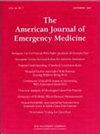Unmasking CHANTER syndrome: A rare neurological consequence of opioid overdose
IF 2.7
3区 医学
Q1 EMERGENCY MEDICINE
引用次数: 0
Abstract
The opioid epidemic remains a major public health issue in the U.S., with over 100,000 overdose deaths in 2022, many linked to synthetic opioids. Emergency medicine plays a vital role in managing opioid overdoses, which typically cause CNS depression and respiratory failure. However, atypical presentations are becoming more common, complicating diagnosis and treatment. This case report discusses a patient who developed focal neurologic deficits after an opioid overdose and was found to have radiographic findings suggestive of CHANTER syndrome.
Cerebellar-Hippocampal-Basal Nuclei Transient Edema with Restricted Diffusion (CHANTER syndrome), first described in 2019, is marked by restricted diffusion and edema in the cerebellum, hippocampus, and basal ganglia. While most cases involve comatose patients requiring intensive care, the emergency department presentation is less understood. The differential diagnosis includes hypoxic-ischemic encephalopathy, posterior reversible encephalopathy syndrome, and heroin-associated spongiform leukoencephalopathy. Unlike ischemic infarcts, CHANTER syndrome can show significant improvement with aggressive management.
Given the rise of opioid use, emergency physicians are likely to encounter more cases with similar presentations. MRI imaging should be considered in patients who do not recover as expected following an opioid overdose. Early identification of complications like CHANTER syndrome can lead to closer neurologic monitoring and neurosurgical intervention that may prevent decompensation or even death.
求助全文
约1分钟内获得全文
求助全文
来源期刊
CiteScore
6.00
自引率
5.60%
发文量
730
审稿时长
42 days
期刊介绍:
A distinctive blend of practicality and scholarliness makes the American Journal of Emergency Medicine a key source for information on emergency medical care. Covering all activities concerned with emergency medicine, it is the journal to turn to for information to help increase the ability to understand, recognize and treat emergency conditions. Issues contain clinical articles, case reports, review articles, editorials, international notes, book reviews and more.

 求助内容:
求助内容: 应助结果提醒方式:
应助结果提醒方式:


